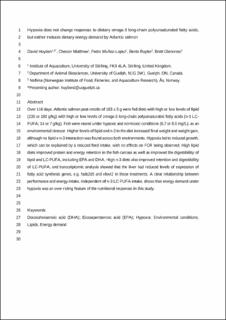| dc.contributor.author | Huyben, David | |
| dc.contributor.author | Matthew, Chessor | |
| dc.contributor.author | Muñoz-Lopez, Pedro | |
| dc.contributor.author | Ruyter, Bente Synnøve | |
| dc.contributor.author | Glencross, Brett D. | |
| dc.date.accessioned | 2022-03-10T08:24:44Z | |
| dc.date.available | 2022-03-10T08:24:44Z | |
| dc.date.created | 2022-02-05T16:54:49Z | |
| dc.date.issued | 2021 | |
| dc.identifier.citation | Aquaculture Nutrition. 2021, 27 (5), 1396-1410. | |
| dc.identifier.issn | 1353-5773 | |
| dc.identifier.uri | https://hdl.handle.net/11250/2984146 | |
| dc.description.abstract | Over 116 days, Atlantic salmon postsmolts of 183 ± 5 g were fed diets with high or low levels of lipid (230 or 180 g/kg) with high or low levels of omega-3 long-chain polyunsaturated fatty acids (n-3 LC-PUFA; 14 or 7 g/kg). Fish were reared under hypoxic and normoxic conditions (6.7 or 8.0 mg/L), as an environmental stressor. Higher levels of lipid and n-3 in the diet increased final weight and weight gain, although no lipid x n-3 interaction was found across both environments. Hypoxia led to reduced growth, which can be explained by reduced feed intake, with no effects on FCR being observed. High lipid diets improved protein and energy retention in the fish carcass as well as improved the digestibility of lipid and LC-PUFA, including EPA and DHA. High n-3 diets also improved retention and digestibility of LC-PUFA, and transcriptomic analysis showed that the liver had reduced levels of expression of fatty acid synthesis genes, for example fads2d5 and elovl2 in those treatments. A clear relationship between performance and energy intake, independent of n-3 LC-PUFA intake, shows that energy demand under hypoxia was an over-riding feature of the nutritional responses in this study. | |
| dc.language.iso | eng | |
| dc.title | Hypoxia does not change responses to dietary omega-3 long-chain polyunsaturated fatty acids, but rather reduces dietary energy demand by Atlantic salmon | |
| dc.type | Peer reviewed | |
| dc.type | Journal article | |
| dc.description.version | submittedVersion | |
| dc.source.pagenumber | 1396-1410 | |
| dc.source.volume | 27 | |
| dc.source.journal | Aquaculture Nutrition | |
| dc.source.issue | 5 | |
| dc.identifier.doi | 10.1111/anu.13278 | |
| dc.identifier.cristin | 1998122 | |
| dc.relation.project | Norges forskningsråd: 273202 | |
| dc.relation.project | Fiskeri- og havbruksnæringens forskningsfinansiering: 901282 | |
| dc.relation.project | Nofima AS: 11887 | |
| cristin.ispublished | true | |
| cristin.fulltext | preprint | |
| cristin.qualitycode | 1 | |
